Xin Shi
MASTER: Multi-Agent Security Through Exploration of Roles and Topological Structures -- A Comprehensive Framework
May 24, 2025Abstract:Large Language Models (LLMs)-based Multi-Agent Systems (MAS) exhibit remarkable problem-solving and task planning capabilities across diverse domains due to their specialized agentic roles and collaborative interactions. However, this also amplifies the severity of security risks under MAS attacks. To address this, we introduce MASTER, a novel security research framework for MAS, focusing on diverse Role configurations and Topological structures across various scenarios. MASTER offers an automated construction process for different MAS setups and an information-flow-based interaction paradigm. To tackle MAS security challenges in varied scenarios, we design a scenario-adaptive, extensible attack strategy utilizing role and topological information, which dynamically allocates targeted, domain-specific attack tasks for collaborative agent execution. Our experiments demonstrate that such an attack, leveraging role and topological information, exhibits significant destructive potential across most models. Additionally, we propose corresponding defense strategies, substantially enhancing MAS resilience across diverse scenarios. We anticipate that our framework and findings will provide valuable insights for future research into MAS security challenges.
DecoupledESC: Enhancing Emotional Support Generation via Strategy-Response Decoupled Preference Optimization
May 22, 2025Abstract:Recent advances in Emotional Support Conversation (ESC) have improved emotional support generation by fine-tuning Large Language Models (LLMs) via Supervised Fine-Tuning (SFT). However, common psychological errors still persist. While Direct Preference Optimization (DPO) shows promise in reducing such errors through pairwise preference learning, its effectiveness in ESC tasks is limited by two key challenges: (1) Entangled data structure: Existing ESC data inherently entangles psychological strategies and response content, making it difficult to construct high-quality preference pairs; and (2) Optimization ambiguity: Applying vanilla DPO to such entangled pairwise data leads to ambiguous training objectives. To address these issues, we introduce Inferential Preference Mining (IPM) to construct high-quality preference data, forming the IPM-PrefDial dataset. Building upon this data, we propose a Decoupled ESC framework inspired by Gross's Extended Process Model of Emotion Regulation, which decomposes the ESC task into two sequential subtasks: strategy planning and empathic response generation. Each was trained via SFT and subsequently enhanced by DPO to align with the psychological preference. Extensive experiments demonstrate that our Decoupled ESC framework outperforms joint optimization baselines, reducing preference bias and improving response quality.
Stochastic Gradient Descent in Non-Convex Problems: Asymptotic Convergence with Relaxed Step-Size via Stopping Time Methods
Apr 17, 2025Abstract:Stochastic Gradient Descent (SGD) is widely used in machine learning research. Previous convergence analyses of SGD under the vanishing step-size setting typically require Robbins-Monro conditions. However, in practice, a wider variety of step-size schemes are frequently employed, yet existing convergence results remain limited and often rely on strong assumptions. This paper bridges this gap by introducing a novel analytical framework based on a stopping-time method, enabling asymptotic convergence analysis of SGD under more relaxed step-size conditions and weaker assumptions. In the non-convex setting, we prove the almost sure convergence of SGD iterates for step-sizes $ \{ \epsilon_t \}_{t \geq 1} $ satisfying $\sum_{t=1}^{+\infty} \epsilon_t = +\infty$ and $\sum_{t=1}^{+\infty} \epsilon_t^p < +\infty$ for some $p > 2$. Compared with previous studies, our analysis eliminates the global Lipschitz continuity assumption on the loss function and relaxes the boundedness requirements for higher-order moments of stochastic gradients. Building upon the almost sure convergence results, we further establish $L_2$ convergence. These significantly relaxed assumptions make our theoretical results more general, thereby enhancing their applicability in practical scenarios.
Real-Time Privacy Risk Measurement with Privacy Tokens for Gradient Leakage
Feb 07, 2025



Abstract:The widespread deployment of deep learning models in privacy-sensitive domains has amplified concerns regarding privacy risks, particularly those stemming from gradient leakage during training. Current privacy assessments primarily rely on post-training attack simulations. However, these methods are inherently reactive, unable to encompass all potential attack scenarios, and often based on idealized adversarial assumptions. These limitations underscore the need for proactive approaches to privacy risk assessment during the training process. To address this gap, we propose the concept of privacy tokens, which are derived directly from private gradients during training. Privacy tokens encapsulate gradient features and, when combined with data features, offer valuable insights into the extent of private information leakage from training data, enabling real-time measurement of privacy risks without relying on adversarial attack simulations. Additionally, we employ Mutual Information (MI) as a robust metric to quantify the relationship between training data and gradients, providing precise and continuous assessments of privacy leakage throughout the training process. Extensive experiments validate our framework, demonstrating the effectiveness of privacy tokens and MI in identifying and quantifying privacy risks. This proactive approach marks a significant advancement in privacy monitoring, promoting the safer deployment of deep learning models in sensitive applications.
Privacy Token: Surprised to Find Out What You Accidentally Revealed
Feb 06, 2025



Abstract:The widespread deployment of deep learning models in privacy-sensitive domains has amplified concerns regarding privacy risks, particularly those stemming from gradient leakage during training. Current privacy assessments primarily rely on post-training attack simulations. However, these methods are inherently reactive, unable to encompass all potential attack scenarios, and often based on idealized adversarial assumptions. These limitations underscore the need for proactive approaches to privacy risk assessment during the training process. To address this gap, we propose the concept of privacy tokens, which are derived directly from private gradients during training. Privacy tokens encapsulate gradient features and, when combined with data features, offer valuable insights into the extent of private information leakage from training data, enabling real-time measurement of privacy risks without relying on adversarial attack simulations. Additionally, we employ Mutual Information (MI) as a robust metric to quantify the relationship between training data and gradients, providing precise and continuous assessments of privacy leakage throughout the training process. Extensive experiments validate our framework, demonstrating the effectiveness of privacy tokens and MI in identifying and quantifying privacy risks. This proactive approach marks a significant advancement in privacy monitoring, promoting the safer deployment of deep learning models in sensitive applications.
Enhancing DP-SGD through Non-monotonous Adaptive Scaling Gradient Weight
Nov 05, 2024Abstract:In the domain of deep learning, the challenge of protecting sensitive data while maintaining model utility is significant. Traditional Differential Privacy (DP) techniques such as Differentially Private Stochastic Gradient Descent (DP-SGD) typically employ strategies like direct or per-sample adaptive gradient clipping. These methods, however, compromise model accuracy due to their critical influence on gradient handling, particularly neglecting the significant contribution of small gradients during later training stages. In this paper, we introduce an enhanced version of DP-SGD, named Differentially Private Per-sample Adaptive Scaling Clipping (DP-PSASC). This approach replaces traditional clipping with non-monotonous adaptive gradient scaling, which alleviates the need for intensive threshold setting and rectifies the disproportionate weighting of smaller gradients. Our contribution is twofold. First, we develop a novel gradient scaling technique that effectively assigns proper weights to gradients, particularly small ones, thus improving learning under differential privacy. Second, we integrate a momentum-based method into DP-PSASC to reduce bias from stochastic sampling, enhancing convergence rates. Our theoretical and empirical analyses confirm that DP-PSASC preserves privacy and delivers superior performance across diverse datasets, setting new standards for privacy-sensitive applications.
TRIS-HAR: Transmissive Reconfigurable Intelligent Surfaces-assisted Cognitive Wireless Human Activity Recognition Using State Space Models
Oct 03, 2024



Abstract:Human activity recognition (HAR) using radio frequency (RF) signals has garnered considerable attention for its applications in smart environments. However, traditional systems often struggle with limited independent channels between transmitters and receivers, multipath fading, and environmental noise, which particularly degrades performance in through-the-wall scenarios. In this paper, we present a transmissive reconfigurable intelligent surface (TRIS)-assisted through-the-wall human activity recognition (TRIS-HAR) system. The system employs TRIS technology to actively reshape wireless signal propagation, creating multiple independent paths to enhance signal clarity and improve recognition accuracy in complex indoor settings. Additionally, we propose the Human intelligence Mamba (HiMamba), an advanced state space model that captures temporal and frequency-based information for precise activity recognition. HiMamba achieves state-of-the-art performance on two public datasets, demonstrating superior accuracy. Extensive experiments indicate that the TRIS-HAR system improves recognition performance from 85.00% to 98.06% in laboratory conditions and maintains high performance across various environments. This approach offers a robust solution for enhancing RF-based HAR, with promising applications in smart home and elderly care systems.
TRGR: Transmissive RIS-aided Gait Recognition Through Walls
Jul 31, 2024



Abstract:Gait recognition with radio frequency (RF) signals enables many potential applications requiring accurate identification. However, current systems require individuals to be within a line-of-sight (LOS) environment and struggle with low signal-to-noise ratio (SNR) when signals traverse concrete and thick walls. To address these challenges, we present TRGR, a novel transmissive reconfigurable intelligent surface (RIS)-aided gait recognition system. TRGR can recognize human identities through walls using only the magnitude measurements of channel state information (CSI) from a pair of transceivers. Specifically, by leveraging transmissive RIS alongside a configuration alternating optimization algorithm, TRGR enhances wall penetration and signal quality, enabling accurate gait recognition. Furthermore, a residual convolution network (RCNN) is proposed as the backbone network to learn robust human information. Experimental results confirm the efficacy of transmissive RIS, highlighting the significant potential of transmissive RIS in enhancing RF-based gait recognition systems. Extensive experiment results show that TRGR achieves an average accuracy of 97.88\% in identifying persons when signals traverse concrete walls, demonstrating the effectiveness and robustness of TRGR.
A Survey of Fairness in Medical Image Analysis: Concepts, Algorithms, Evaluations, and Challenges
Sep 27, 2022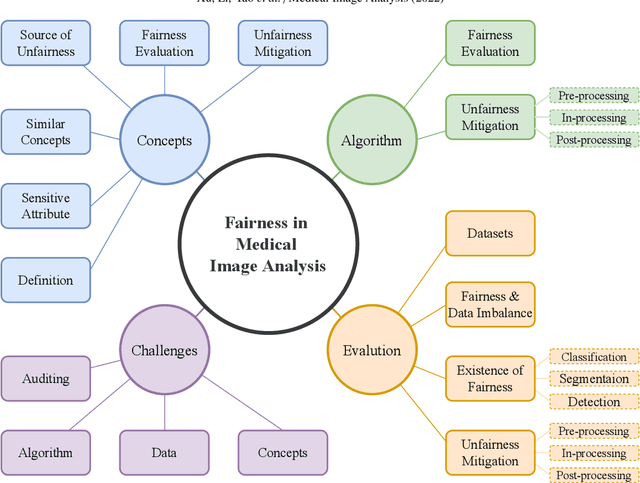
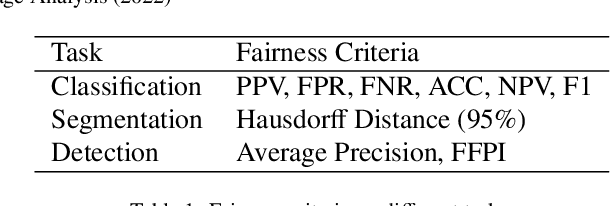

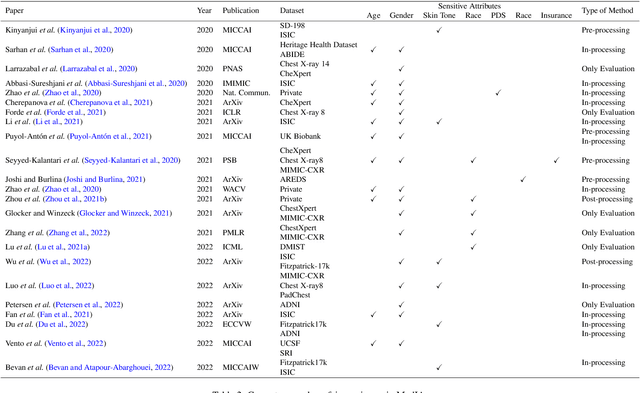
Abstract:Fairness, a criterion focuses on evaluating algorithm performance on different demographic groups, has gained attention in natural language processing, recommendation system and facial recognition. Since there are plenty of demographic attributes in medical image samples, it is important to understand the concepts of fairness, be acquainted with unfairness mitigation techniques, evaluate fairness degree of an algorithm and recognize challenges in fairness issues in medical image analysis (MedIA). In this paper, we first give a comprehensive and precise definition of fairness, following by introducing currently used techniques in fairness issues in MedIA. After that, we list public medical image datasets that contain demographic attributes for facilitating the fairness research and summarize current algorithms concerning fairness in MedIA. To help achieve a better understanding of fairness, and call attention to fairness related issues in MedIA, experiments are conducted comparing the difference between fairness and data imbalance, verifying the existence of unfairness in various MedIA tasks, especially in classification, segmentation and detection, and evaluating the effectiveness of unfairness mitigation algorithms. Finally, we conclude with opportunities and challenges in fairness in MedIA.
Learning to Reduce False Positives in Analytic Bug Detectors
Mar 08, 2022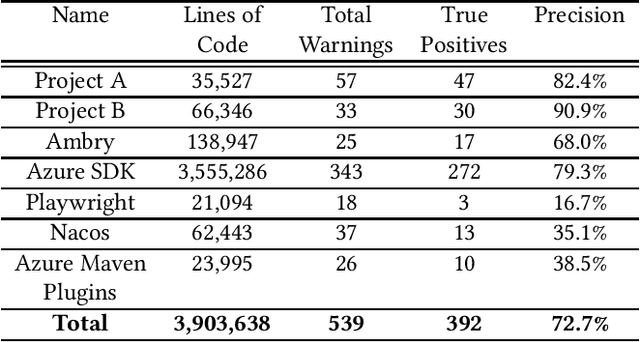


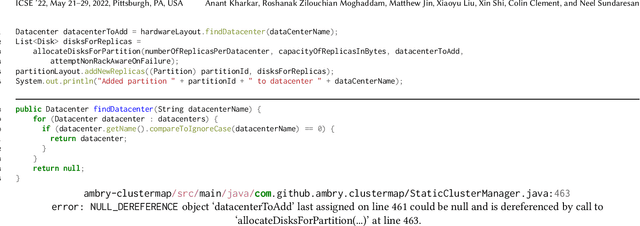
Abstract:Due to increasingly complex software design and rapid iterative development, code defects and security vulnerabilities are prevalent in modern software. In response, programmers rely on static analysis tools to regularly scan their codebases and find potential bugs. In order to maximize coverage, however, these tools generally tend to report a significant number of false positives, requiring developers to manually verify each warning. To address this problem, we propose a Transformer-based learning approach to identify false positive bug warnings. We demonstrate that our models can improve the precision of static analysis by 17.5%. In addition, we validated the generalizability of this approach across two major bug types: null dereference and resource leak.
 Add to Chrome
Add to Chrome Add to Firefox
Add to Firefox Add to Edge
Add to Edge